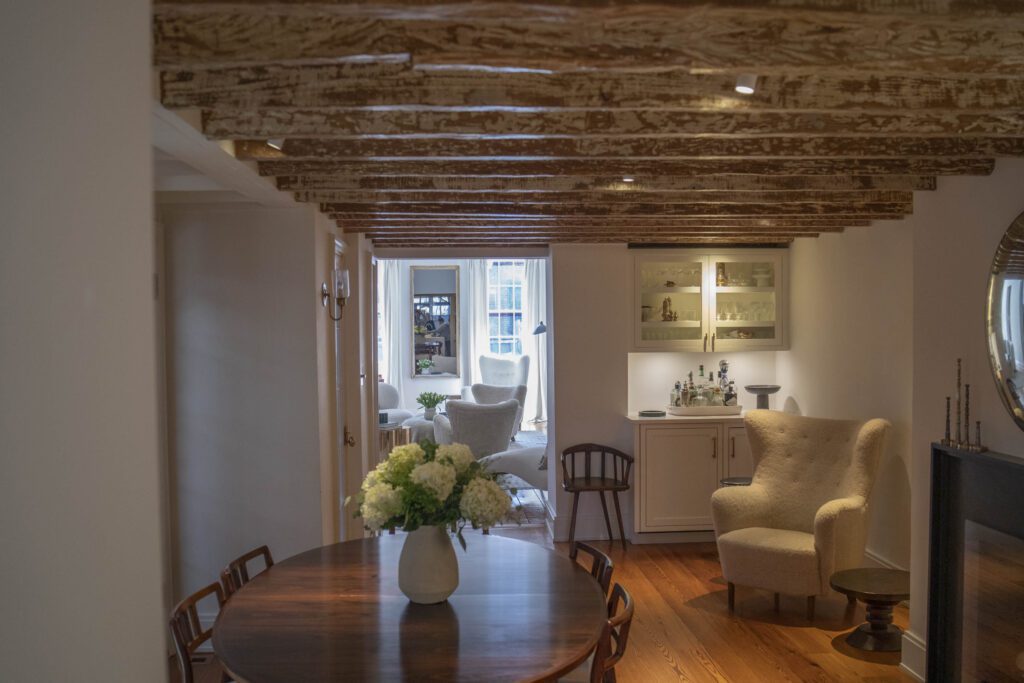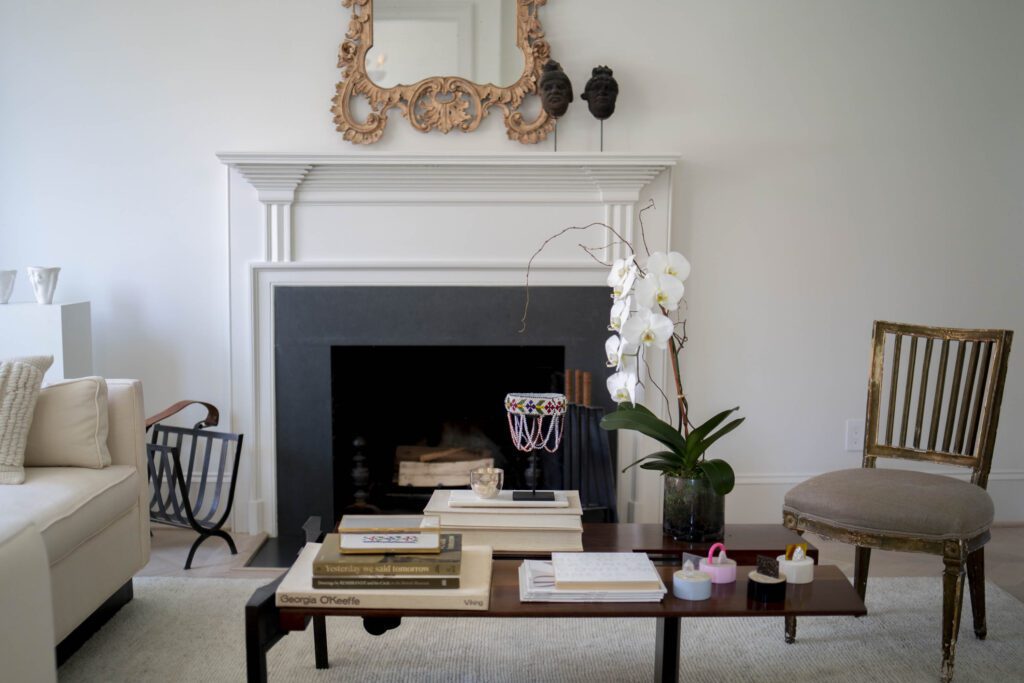Celebrating 90 Years, the Georgetown House Tour Returns on April 22
By • April 12, 2023 0 2865

On April 22, the annual Georgetown House Tour returns for its 90th showing — opening nine historic and exceptional houses (one, a house of worship) of varying styles to local and out-of-town guests, likely numbering more than 1,800. The tour is believed to be the oldest, most prestigious house tour in the country.
Ninety never looked so good — and so do the nine places on the tour. With committed homeowners, architects, designers and tour volunteers, it takes a village to put on an event that has raised millions to support charities that serve those in need in Georgetown and beyond since 1931.
“Today, St. John’s Episcopal Church celebrates the 90th running of the Georgetown House Tour, annually benefitting the many missions and ministries supported by the church community,” says Donna Leanos, chair of this year’s Georgetown House Tour. “During the 1930s, a time of upheaval in our country, folks were searching for ways to help those who were less fortunate and who had fallen on very difficult times. Many residents of Georgetown were hungry and living in unhealthy conditions at that time. Mrs. Jefferson Randolph Kean noticed this problem and decided to organize a tour of the many beautiful and historically significant homes of Georgetown, charging a fee that would ultimately support these neighbors.”
St. John’s Church, Georgetown Parish, is engaged in many outreach programs, supported, in part, by the Georgetown House Tour. Over the past few years, St. John’s has funded a broad range of human service organizations, including: Bishop Walker School, Bright Beginnings, Cornerstone Community, Seabury Senior Ministries, Georgetown Ministry Center, Grate Patrol, Jubilee Jobs, DC Volunteer Lawyers Project, Manna, Metro Teens & Pediatric AIDS, New Futures and Joseph House (all in the Washington metro area), in addition to Seafarers & International House, American Near East Refugee Aid, Episcopal Diocese of Jerusalem and Honduras Support through the Episcopal Diocese of Washington.
Chaired by Kathryn Minor Jones, the Patron’s Party — created by tour benefactor Frida Burling — will kick off the action for the Georgetown House Tour with a stylish reception on April 19 at the Hawkins residence (the Henry Foxhall house) on Dumbarton Street.
On Saturday, April 22, the self-guided tour — 11 a.m. to 5 p.m. — will begin at St. John’s Church on O Street, where guests will receive a House Tour magazine with maps and histories on each property. Attendees will also receive admission to the Parish Tea, held in Blake Hall at the church.
The homes are certainly exceptional and historic — well-known architect Christian Zapatka invites attendees to four special places, including his residence and his home office.
“It’s always a pleasure and an honor to offer glimpses, both interior and exterior, of historic houses that we have had the privilege of restoring, expanding and ushering into the 21st century — lots to discover behind the historic facades!” says Zapatka.
Designer Azali Kassum worked with Zapatka on one of the houses on the tour and is opening her own home for the day. Her Georgetown story — like Zapatka’s — is both personal and professional.
She met her now husband, Ian Myers, when the two were teenagers attending the American Embassy School in New Delhi, India, in the late 1980s.
“Our parents were all stationed there for work, and Ian and I were both in the same high school science class,” Kassum says. “We reconnected 25 years later, when Ian, rather serendipitously, came across my name while researching law firms with a presence in India. I was living in Georgetown at the time which really set the stage for our courtship and our decision to settle here. We love the neighborhood, its history, and how walkable it is, whether with our dog or to our favorite date night destinations, such as Apero, Chez Billy and Martin’s Tavern. All three of our children have attended Little Folks School.”
“Our entire day to day life revolves around this community, and the Georgetown House Tour is such a fabulous way to give back. All the homes which participate each year provide an incredible view to the design, architecture and history of Georgetown and how families live today — each a gem in its own right.”
As for her design philosophy, Kassum says, “I’ve always had a passion for design, inspired by my mother’s love of antiquing and our global travels throughout my childhood. Creating and recreating living spaces were often my great escape from practicing law. My minimalist and organic approach to design is rooted in the belief that your home should reflect who you are, what you love and how you live while creating a sanctuary from the chaos of every day. I love layering natural textures, materials and finishes with curated and meaningful pieces, the unexpected contrast of which draws your eye and connects you to a space. Design for me is also fluid, ever evolving and transformative. The entire process excites me, from configuring floor plans for how a family functions in their home carries equal weight to how it is ultimately decorated.”
Kassum adds: “Our home, featured on the tour, served as exploration of this — taking a 1790s Federal down to its bones, revealing the original brick, beams, thresholds and lintels — and pulling it back together by opening rooms to bring in the outdoors. It’s a surprise to most who walk through to see these deconstructed and simplified spaces which also feel warm and inviting.”
Indeed, it does take a village to show off the charms of the oldest neighborhood in the nation’s capital. We know the walls have ears and more. So, if you look and listen very hard, you’ll learn a little more about Georgetown.
On the 2023 Tour —
A list of participating homes for this year’s house tour are below, as provided by tour officials:
1. 1308 29th St. NW
This Federal-style house was built in 1825 and expanded in 1930, adding a wing in the rear of the house that is now the kitchen and dining room, as well as a detached garage. Dubbed the Georgetown “Spy House,” this home was once owned by Frank Wisner, a founding father of the Central Intelligence Agency. Allen Dulles, the first civilian director of the CIA, also lived here during the 1950s.

3023 P St. NW. Photo by Jordan Tovin.
2. 3023 P St. NW
This 1800 federal townhouse on the east side of Georgetown is often referred to as the “Seam House” because of the vertical seam running down its brick façade. The two-story core of the home was originally used as a workshop but now functions as the dining room and features original exposed beams. In 1814, the home was purchased as an investment by Washington Bowie, a Scottish tobacco merchant and colonel in the Maryland militia. Bowie was also the godson of George Washington (who was present at his christening) and founding vestryman in 1796 of St. John’s Church. In 2015, the homeowners with architect Christian Zapatka restored the home.

1347 30th St. NW. Photo by Jordan Tovin.
3. 1347 30th St. NW
Longtime owner Hannah M. Parker, who living until the age of 98, recalled President Teddy Roosevelt riding his horse past her house when the streets were dirt. This elegant sun-filled 1900s Victorian now offers elegant architectural details and an extensive art collection. Bleached floors and an all-neutral color scheme reflect the modern architectural changes made by architect Christian Zapatka and interior designer Azali Kassum. This home’s history showed a third floor that had been lost in a fire. After much study and planning, the home was restored to its original beauty and usefulness.

1615 31st St. NW. Photo by Jordan Tovin.
4. 1615 31st St. NW
Hidden away in a charming enclave of Georgian center hall colonials — built in the 1980s on the site of the historic Smith-Winslow House — this home is a delight, tastefully redesigned by architect John Cecchi of Cecchi Homes with both family living and formal entertaining in mind. The owners have filled the home with unique artwork that stands as focal points throughout.
5. 1698 31st St. NW
Near the entrance to Dumbarton Oaks and set among other historic residences like the Taft Mansion and Tudor Place, this grand five-level Victorian home was built in 1898 and is formerly part of McLean’s Lot. The elegant facade and welcoming foyer are an invitation to the graciousness of this sophisticated bow front Victorian townhouse that boasts bright rooms with large windows, five fireplaces, numerous bookcases, tall ceilings with crown molding and wooden floors. It was restored by current owners, Daniel Chao and Jeff Berkowitz. The previous owner of 30 years was Dr. Norma Evenson, an architect, urban historian, and a prize-winning author of architecture and urban planning books.
6. 3235 P St. NW
This house is one of four built by Emmert & Heisley in 1886 as companions to one another. Given the window layout, it is clear that this property was constructed as a residence, although it has enjoyed various uses throughout the years — a boarding house, a shop of distinguished art and antiques, an art gallery, a jewelry store and a confectionery shop. It is now the office of Christian Zapatka Architect. The redesigned spaces are adorned with storied effects throughout. Zapatka has brought true meaning to the term, “home office.”
7. 1416 34th St. NW
An Italianate-style house built in 1876, this stately detached brick federal, known as the Wetzel-Graves home, was renovated by architect Dale Overmyer and features hard wood floors and crown molding throughout its grand living spaces. The side and rear outdoor space and gardens feature an artist’s studio, which is also used as a guest house. The artist’s works can be seen throughout the house.
8. 1413 35th St. NW
In 2005, architect Christian Zapatka transformed this intimate 1,480-square-foot home built in 1900 to reflect the modern-day conveniences, while keeping the traditional Georgetown charm. The living room across the back of the house opens directly on to a limestone terrace through three sets of tall French doors. The home features a beautiful, terraced garden that is a must see.
9. 3001 R St. NW
In Oak Hill Cemetery, Renwick Chapel built in 1850 was designed by James Renwick, Jr. A National Historic Landmark, it is an example of Gothic Revival architecture and often called a “miniature Gothic gem.” The chapel has hosted funerals and weddings for the past 173 years, with notable guests including presidents and cabinet members. Renwick’s work includes the Smithsonian Building, the original Corcoran Gallery of Art (now the Renwick Gallery) and St. Patrick’s Cathedral in New York City.
Visit GeorgetownHouseTour.com for more information.

